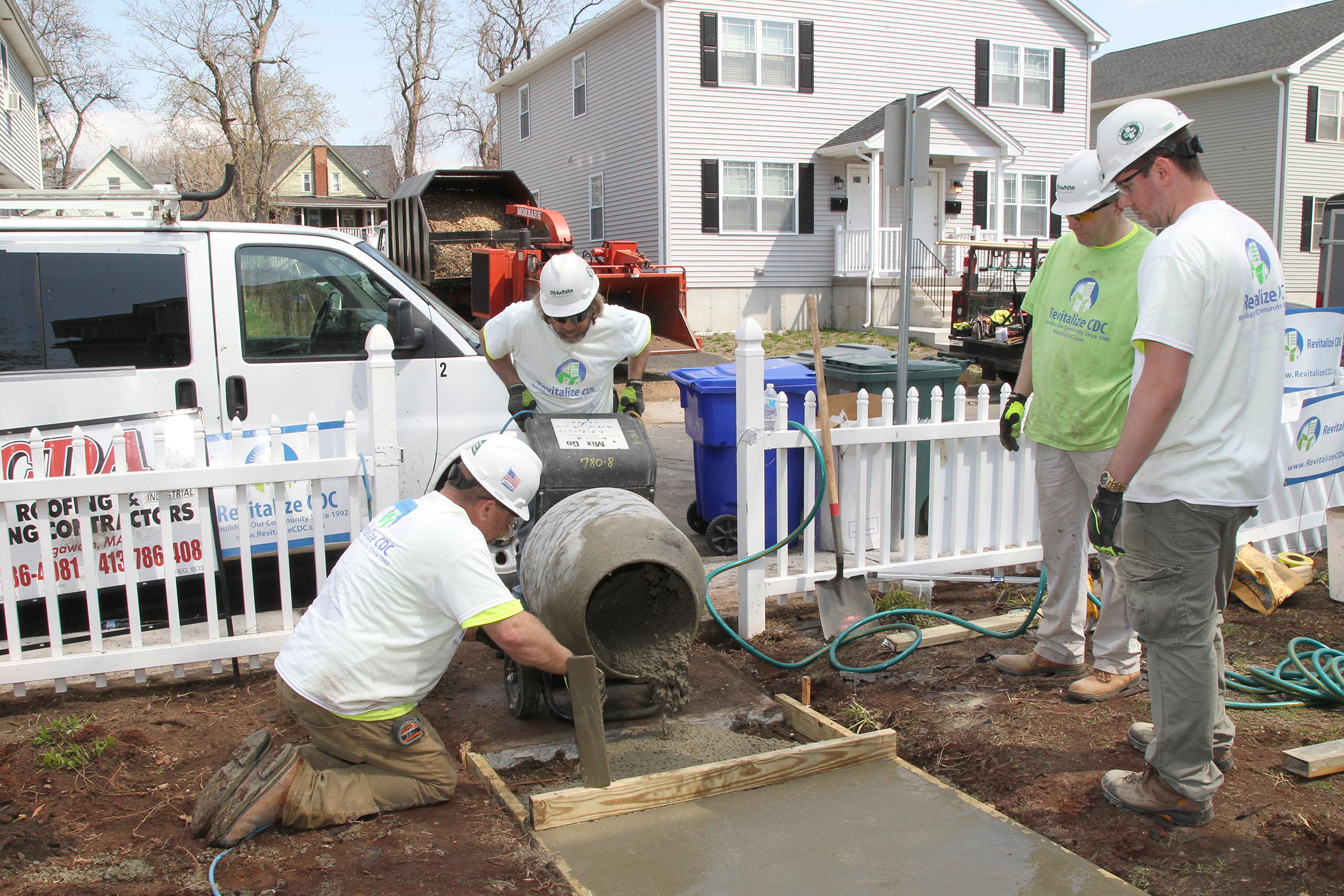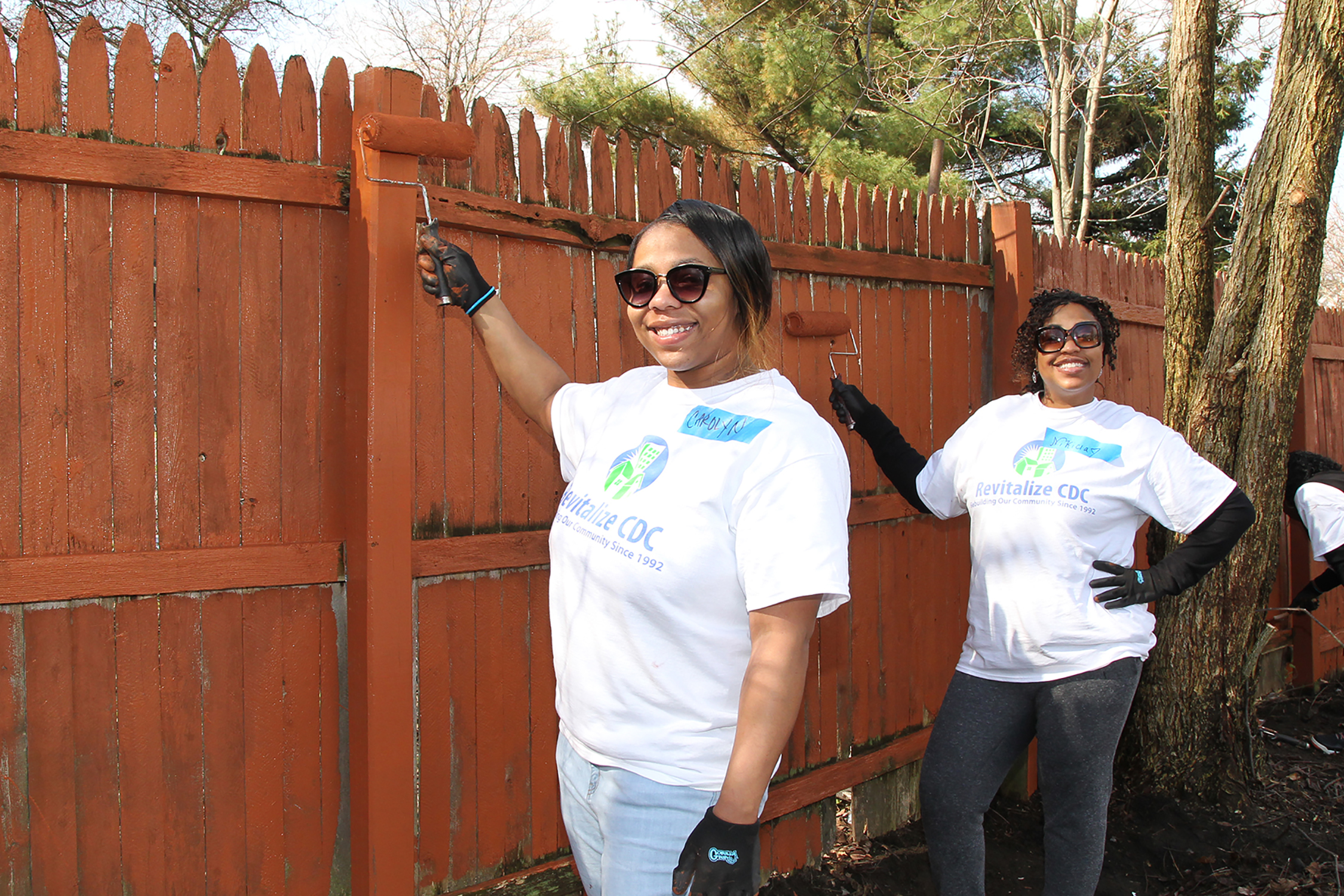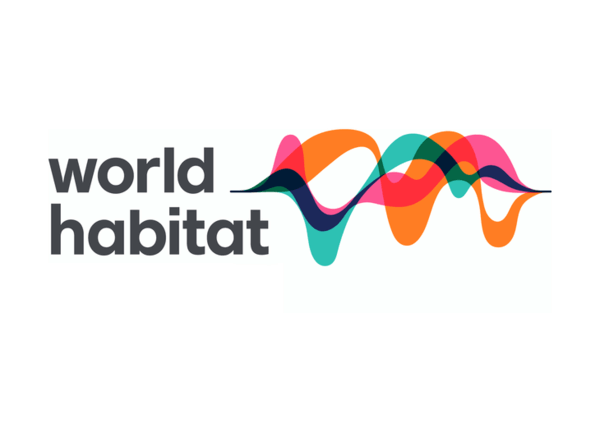 #GNF Construction Volunteers - © World Habitat
#GNF Construction Volunteers - © World Habitat #GNF Morning Kickoff - © World Habitat
#GNF Morning Kickoff - © World Habitat #GNF Neighborhood Volunteer - © World Habitat
#GNF Neighborhood Volunteer - © World Habitat #GNF Volunteers - © World Habitat
#GNF Volunteers - © World Habitat #GNF Volunteers - Community Center - © World Habitat
#GNF Volunteers - Community Center - © World Habitat
City
Springfield
Main actors
Local Government, NGO / Philanthropy, Community / Citizen Group, other
Project area
Neighborhood or district
Duration
Ongoing since 1992
An urban renewal project with community participation and support.
#GreenNFit Neighbourhood Rebuild started in 1992 and was then developed into a 10-year project - ’10-in-10’ - to improve or rebuild homes and community spaces, based on a neighbourhood development plan designed with residents and local organisations. It delivers a day of mass action in one city block, before moving on to an adjacent block the following year, for 10 years. Up to 2,000 volunteers from all over the city, local businesses and other stakeholder organisations work on improving homes and open spaces. This involves providing critical repairs, modifications and restoration on homes and non-profit facilities, to improve energy-efficiency, safety, accessibility and health.
The process for the first #GreenNFit project, in the Old Hill Neighbourhood, Springfield, Massachusetts, started on 1 January 2012. The 10 blocks have been completed ahead of schedule (in seven years - completed in 2019) as in several years they worked on two contiguous blocks instead of one.
The entire population of the Old Hill Neighbourhood of Springfield (4,371 people) has benefited from improvements to facilities and public spaces. This includes clearing 33 vacant lots, developing a city playground, providing two community gardens, improving five non-profit facilities, and upgrading a school for at-risk students.
The project has directly benefited 191 households (the number of homes that have been repaired), including 25 for military veterans, 188 elderly residents, 76 people with special needs and 251 children.
The model has also transferred to the nearby city of Holyoke with the first event held in October 2016.
World Habitat Awards
This project was shortlisted for the 'World Habitat Awards' in 2019 in the following category: Bronze.
The cities of Springfield and Holyoke are two of the poorest and most ethnically diverse communities in the state of Massachusetts. Almost one-in-three (29.7% in Springfield and 28.6% in Holyoke) live below the poverty line, including 29% of children in Holyoke (the highest in Massachusetts). Around one-in-seven (13.6%) are aged over 65; a similar proportion (13.25%) aged below 65 have a disability; and there are almost 2,000 military veterans.
Over half of Holyoke’s residents are non-Caucasian (50% Hispanic/Latino and 4.4% African American) and in Springfield it is almost half (48%). Studies show that people of colour and low-income individuals are the populations most affected by poor housing conditions that in turn lead to poor health - respiratory infections, asthma, lead poisoning and worsening mental health issues.
The city of Springfield has an ageing housing stock, with approaching half (40%) of all homes built before 1940 and the vast majority (86%) built before 1980 (Census, 2012). These old homes have a number of issues, including moisture, cold and pest problems. Around 89% of homes in Springfield were built before lead paint became illegal in 1978 - Springfield has lead poisoning rates three times higher than the state average.
Between 2011-2013, Springfield was hit by five tornadoes which devastated buildings and low-income houses. Many homeowners either had inadequate insurance policies or no policies at all to cover the cost of rebuilding or repairing their homes. These ‘Presidentially-declared’ 1 disasters - and the devastation caused by them - inspired and motivated Revitalize CDC to implement a strategic plan for the #GreenNFit project in this neighbourhood.
Other projects delivered by Revitalize CDC include ‘REO Rehab Program’ (upgrading and improving houses due for foreclosure, to be made available for purchase for low-income families); ’Joined Forces Military Veterans Services’ (home repair project work for military veterans in need); and ‘Green & Healthy Homes’ (a partnership with Baystate Health, Public Health Institute of Western Massachusetts, Pioneer Valley Asthma Coalition, City of Springfield and Square One to improve housing conditions for asthma sufferers).
Objectives
The key aim of #GreenNFit Neighbourhood Rebuild is to work on contiguous urban blocks to repair and improve homes and clean up vacant lots, create community gardens, and improve parks and non-profit facilities.
The goals of the project are to:
- preserve affordable homeownership;
- reduce the risk of homelessness and improve the neighbourhood;
- increase energy efficiency and overall health and safety of houses; and
- improve quality of life, sense of community, and civic pride for residents.
The project directly supports low-income families with a focus on those with children, the elderly, military veterans, and people with special needs. The entire community benefits from visible improvements to the neighbourhood and new social spaces.
#GreenNFit Neighbourhood Rebuild is a project delivered by Revitalize Community Development Corporation (Revitalize CDC), founded in 1992 and based in Massachusetts, USA. It was developed from a Rebuilding Together project, when administrators at local banks recognised the need to revitalise the city of Springfield’s ageing housing stock for low-income families. Although initially a fully volunteer-run organisation, in 2009 it expanded to meet demand including hiring an additional six paid staff making a total of nine. It then went on to become an independent non-profit in 2015.
Past recipients of Revitalize CDC services play an active role in the organisation itself, including one on the Board of Directors and seven volunteers on the #GreenNFit Committee.
Revitalize CDC collaborates with a group of local non-profits (HAPHousing, Springfield Neighbourhood Housing Services and Greater Springfield Habitat for Humanity). The #GreenNFit Springfield project engages around 1,000 volunteers, with an additional 1,000 taking part in volunteer days throughout the year.
The project’s initial planning starts with grass-roots organisations, residents, municipal departments, neighbourhood councils and non-profit organisations all working together to identify areas and residents in most need.
All residents of the community can participate in the work of #GreenNFit, particularly on the improvements to their own home. Tasks are offered that suit people’s ability (e.g. helping serve drinks and food to volunteers, simple construction tasks, or taking part in clearance, gardening and other non-specialist roles). Trained professionals deliver the specialist construction roles (e.g. energy improvements, damp/mould treatment and roof replacement). They allow for flexibility in returning to homes to undertake further repairs after the day of action, through negotiations with the residents.
#GreenNFit’s work on vacant lots, such as unused green spaces and dilapidated playground equipment, uses volunteer tradespeople, and skilled and untrained volunteers. These areas are either cleaned up and repaired or rebuilt to bring back into public use. Some unused green spaces have been converted into community gardens, by planting fruit trees and vegetable gardens.
Revitalize CDC invests approximately $0.5 million USD into each annual block renovation, which is funded by cash and in-kind donations from a range of local, state, federal, and private philanthropic organisations. Supporters include local churches, small businesses, corporations, local health organisations and colleges, including Eversource, MGM Springfield, TD Bank, Costco, BlueCross/Blue Shield Massachusetts, Pioneer Asthma Coalition, Bay Path University, Springfield College, Tufts Health Plan, MA Army National Guard and the Public Health Institute of Western Massachusetts. They have also received grants from corporate and private foundations such as Wells Fargo, Santander Bank, Beveridge Family Foundation, MassMutual and Farmington Bank Foundation. Donations range from small grants of less than $1,000 USD (e.g. Faith United Church) to upwards of $75,000 USD (e.g. MassMutual).
The project relies on a large and recurring volunteer base each year. Revitalize CDC estimates the project receives $229,440 USD worth of volunteering labour each year. Almost all (90%) of volunteers return each year to support the project.
Annual running costs include community outreach; programme and project management; construction and building materials; skilled construction labour; food and water for volunteers; t-shirts; photography; signage; social media; and storage for building materials. These are paid for by funds raised from the aforementioned donors.
The value of materials and labour donated for the repairs has increased steadily as word spreads among business and construction-related communities. The 2019 #GreenNFit event in Springfield (always the last Saturday in April) generated, on average, donations of $19,788 USD per house, including volunteer labour. With 12 houses, seven vacant lots, one elementary school playground, and one community garden all improved, Revitalize CDC evaluated the total cost of community support donations to be worth $486,000 USD, which includes materials and labour provided by trained builders and tradespeople.
Overall costs for future work will remain consistent, in part due to the ongoing bank of volunteers and the in-kind donations (in particular, equipment, food and building supplies).
All services, including time, materials, labour and supplies are provided free of charge to homeowners.
This project relies on a well-run and well-co-ordinated volunteering programme, combined with an efficient local fundraising and donor programme that facilitates cash and in-kind donations from a range of stakeholders within the city of Springfield and wider Massachusetts.
Their success has contributed to further income for the organisation. This year Revitalize CDC will expand their reach state-wide to help military veterans make critical repairs and modifications to their homes from 2019-2022 thanks to a three-year, $730,000 USD Veterans Housing Rehabilitation and Modification Pilot Program (VHRMP) grant.
Evaluation
No external evaluation has been done on this project. However, #GreenNFit completes an in-house evaluation on the project ‘day of action’ and the scope of work completed. Internal staff complete this assessment, including: Revitalize CDC’s Construction Manager; Associate Director, President & CEO; the #GreenNFit Committee (Board members and advisors from the community); and key volunteer team leaders.
They use the following evaluation tools:
- Surveys of homeowners following community action - 99% of homeowners report being very satisfied or satisfied with their assistance.
- Measuring utility bills - Springfield Partners for Community Action (SPCA) reported that for each household assisted, utility costs have been reduced, on average, by $700-800 USD per year.
- Direct observation - using before and after photos of house upgrades.
- Surveys of volunteers - 90% of volunteers return year-on-year to continue supporting the project.
- Data collection from public records - all #GreenNFit homeowners are assisted by Revitalize CDC to be in compliance with the city’s tax department, helping them to negotiate payment plans for any taxes in arrears.
Innovation
The most innovative aspect of the approach is to galvanise large numbers of people to volunteer on a single block in just one day, recruiting and retaining (90%) volunteers, every year. Volunteers are key, as they support the financial sustainability of the programme, while being an effective fundraising and recruitment tool for subsequent days of actions. It fosters a strong sense of community, encourages pride in people’s homes and neighbourhoods, and provides tangible improvements to the standards of living for many disadvantaged residents in the area.
This model makes use of the US tradition of home building, renovation, and retrofitting, and creates strong social bonds across faith and community organisations.
‘Block-by-block’ renovations in the USA are used by a variety of community, construction and development charities with a focus on local neighbourhoods improving the homes of low-income and disadvantaged residents. The #GreenNFit Neighbourhood Rebuild project was itself an adaptation of the Rebuilding Together2 programme, which is a nationwide block-by-block organisation that works in many states across the USA.
Social impact
#GreenNFit reduces social inequalities by delivering free-of-charge improvements, renovations and rehabilitations to homes and public spaces in some of the most low-income areas of Springfield. These are areas that have statistically the lowest level of house price increase, the highest levels of social security claimants, and have traditionally the poorest quality housing across the city. Those with the lowest incomes have traditionally not been able to maintain, upgrade or develop housing stock.
This project breaks down social isolation, increases intergenerational barriers, and fosters community values across the local population. Beneficiaries are encouraged to get involved and retain their volunteer status to take part in future events. Young students have established relationships with elderly residents and have formed socially supportive bonds that continue outside of #GreenNFit events.
Neighbours become more engaged and connected, making the communities healthier and safer. Their work redeveloping open spaces prevents the misuse of public land, encourages participation and socialising through increased sports and leisure activity. As a result of the first #GreenNFit project, neighbours reconnected with each other, or met for the first time, creating their own sense of community and started a neighbourhood watch initiative.
Improvements to people’s homes show well evidenced improvements in heat efficiency, reduction in utility bills and improved health outcomes from issues relating to damp, mould and poor heating. Modifications to homes, such as access ramps, help to prevent injury and illness and allow elderly and disabled people to remain at home.
Environmental impact
Revitalize CDC addresses health and safety modifications needed on old homes while using recycled and environmentally friendly products. The model is based on refreshing and rehabilitating existing buildings, preventing homes being demolished and then completely rebuilt.
#GreenNFit improves homes through the removal of mould, lead, radon, and other materials that may cause chronic health conditions, which poorly maintained homes, especially those built over 50 years ago, can lead to. Older homes also need more heating, which increases oil, gas and electricity use. Revitalize CDC makes energy saving improvements including energy efficient HVAC (heating, ventilation and air conditioning) repairs, double-glazed windows, insulation, water-saving plumbing fixtures, and new roofs, that lower utility usage and monthly bills.
They work with several organisations to recycle waste materials, including the Center for EcoTechnology - and purchase recycled materials from them. They also donate any suitable materials to the Greater Springfield Habitat for Humanity ReStore. Leftover paint is given to the homeowners which they can use to maintain the paintwork, or it is recycled.
Recognition
Revitalize CDC was honoured with the NAACP Community Service Award for their continued effort in helping the community. Members of staff, board and project partners have been awarded a range of local and sector awards including: Joined Forces Award Fundraiser of the Year Award; Community Spotlight Award; Marketing Excellence Award; recognition from Massachusetts Association of Community Development Corporations; Volunteer Leadership Award; and Business West Healthcare Hero for collaboration and innovation in health and wellbeing.
One of the biggest challenges encountered has been working with landlords, many of whom are off-site, out-of-city or even out-of-state. When approached, they have been reluctant to allow Revitalize CDC to work on their properties, despite upgrades and retrofits being needed by the residents and offered for free.
Therefore, Revitalize CDC focus their efforts on owned-homes and non-profit facilities serving the neighbourhoods in which they work. Their goal is that by working on these homes and public spaces, pride for the local neighbourhood will encourage landlords to make repairs to their buildings, and in turn provide better standards of accommodation for tenants. There are also limits to what can be achieved with working on only one block per-year, therefore preventing major structural repairs.
Lessons learned include:
- successful neighbourhood revitalisation improves quality of life by reducing the number of foreclosures and properties in tax arrears; reducing the number of vacant properties and improving the appearance of the neighbourhood; and
- construction activities mean visible signs of change and make a significant contribution to revitalising an entire neighbourhood and community.
These lessons have supported Revitalize CDC to promote strategies to reduce crime, increase walkability, and add value to the neighbourhood.
Transferability
The #GreenNFit model was first adopted in Springfield and has since transferred to Holyoke where town administrators requested Revitalize CDC to carry out work in their city. The first event in Holyoke in 2016 included 200 volunteers improving 10 homes. Since then Revitalize CDC has repaired 19 more homes in Holyoke and invested over $600,000 USD in the city.
Their work has led to interest from other cities, neighbourhoods and communities wanting to deliver similar approaches. To date Revitalize CDC has provided consultation and mentoring to Hartford, CT; Milwaukee, WI; Tampa, FL; Oklahoma City, OK; Henderson, NV; Fayetteville, NC; Phoenix, AZ and Colombia, MD.
External links / documents
On Map
The Map will be displayed after accepting cookie policy
